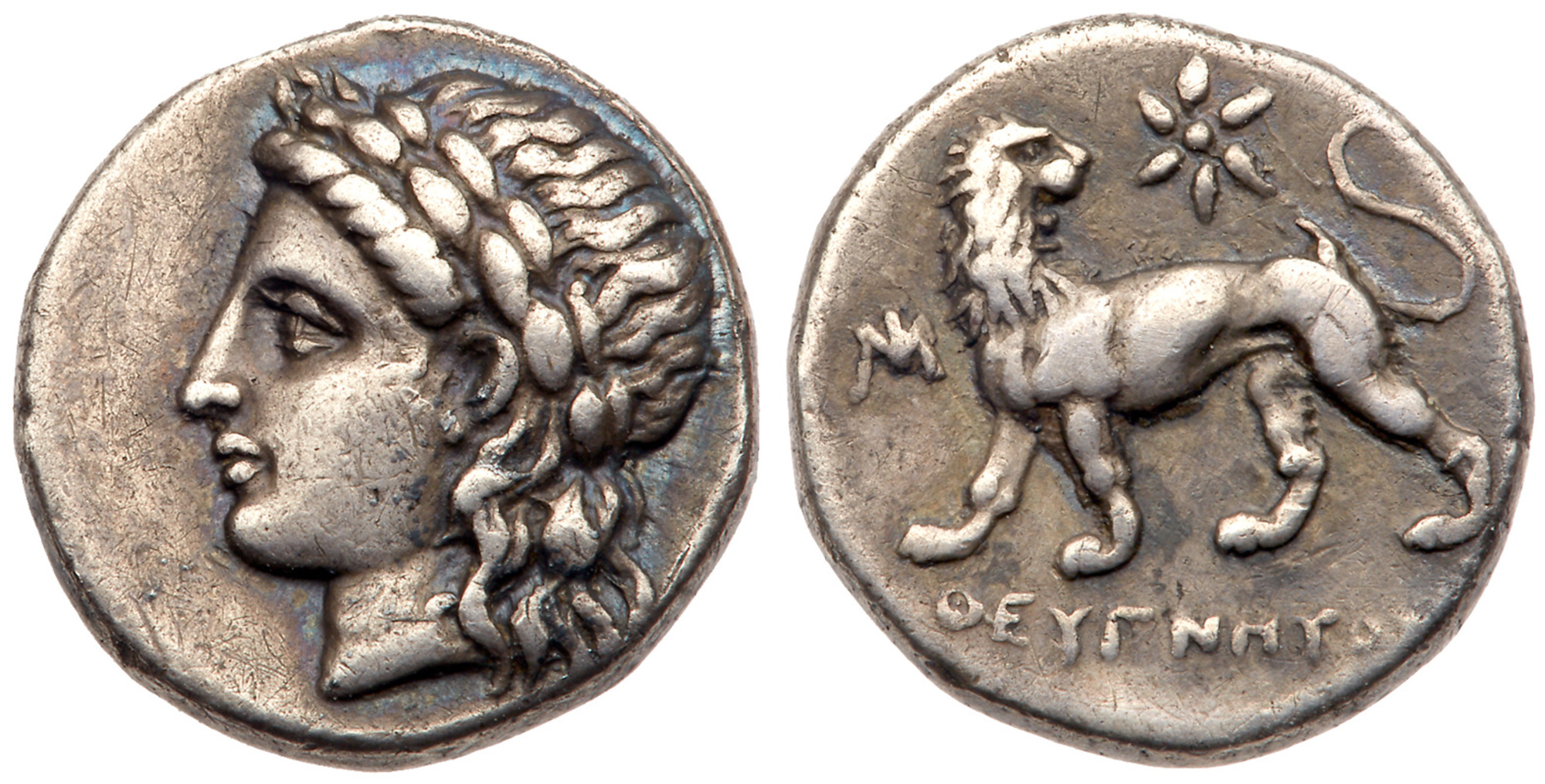Miletus, silver, hemidrachms (353-323 BCE)
From SILVER
353 BCE - 323 BCE Silver 4,276 kg
Description
| ObverseInscription or printing placed on the obverse.: | Head of Apollo left, wearing laurel wreath. |
| ReverseInscription or printing placed on the reverse.: | monogram of the city of Milet (Greek).Lion standing left, head turned to look back, in left field, monogram of city ethnic, above, star, in exergue, magistrate's name: θEYΓNHTOΣ |
Mint and issuing power
| MintIdentifies the place of manufacture or issue of a numismatic object.: | Miletus | Ancient regionAncient region.: | Ionia | Modern countryModern country: Turkey | AuthorityIdentifies the issuing power. The authority can be "pretended" when the name or the portrait of X is on the coin but he/she was not the issuing power. It can also be "uncertain" when there is no mention of X on the coin but he/she was the issuing power according to the historical sources: |
Chronology
| FromIdentifies the initial date in a range assigned in a numismatic context. | 353 BCE | toIdentifies the final date in a range assigned in a numismatic context.. | 323 BCE | PeriodTime period of the numismatic object.: Classical 480-323 BC |
Physical description
| MetalThe physical material (usually metal) from which an object is made.: | Silver |
Median weightMedian of the weights of numismatic objects (in grams). in grams | 1.75 | DenominationTerm indicating the value of a numismatic object. Examples: tetradrachm, chalkous, denarius.: | hemidrachm |
StandardStandard.: |
Image

AC218 Miletus hemidrachms.jpg [1]
References
| Die study referencePublication of the study: | Deppert-Lippitz 19841Deppert-Lippitz 1984, n° 19-67, 152-6, 184-96 and 237-57 | ||
| Coin series referenceReference to coin series study: | Sear II2Sear II, n° 4503, RQEMAC3RQEMAC, n° 218 | ||
| Coin series web referenceCoin series web references: | |||
Obverse dies distribution
| FrequencyFrequency of specimen in distribution. ᵖ | Number of obversesNumber of obverse dies. ᵖ (o) | % (o) | Number of coinsNumber of coins. (n) | % (n) | Die nameName(s) of the die(s). |
| 1 | 42 | 65.63 | 42 | 37.84 | 1.3, 1.4, 1.5, 1.7, 1.14, 1.17, 1.19, 1.20, 1.21, 1.23, 1.24, 1.25, 1.26, 1.28, 1.29, 1.30, 1.32, 2.1, 2.2, 2.3, 2.4, 3.2, 3.3, 3.4, 4.1, 4.2, 4.3, 4.4, 4.5, 4.6, 4.7, 4.8, 4.9, 4.10, 4.11, 4.12, 4.13, 4.14, 4.16, 4.17, 4.18, 4.19 |
| 2 | 11 | 17.19 | 22 | 19.82 | 1.2, 1.6, 1.8, 1.13, 1.16, 1.18, 1.22, 1.27, 1.31, 1.33, 3.5 |
| 3 | 6 | 9.38 | 18 | 16.22 | 1.9, 1.10, 1.11, 1.12, 1.15, 3.8 |
| 4 | 2 | 3.13 | 8 | 7.21 | 3.1, 4.15 |
| 5 | 2 | 3.13 | 10 | 9.01 | 3.6, 3.7 |
| 11 | 1 | 1.56 | 11 | 9.91 | 1.1 |
| Total | 64 of 64 | 100.02 | 111 of 111 | 100.01 |
Reverse dies distribution
no distribution is available
Quantification
| Number of obversesNumber of obverse dies. ᵖ (o) | 64 | Number of singletons (o1)The number of singleton coins. ᵖ | 42 |
| Number of reverse diesNumber of reverse dies. (r) | 70 | Number of coinsNumber of coins. (n) | 111 |
| Coins per obverse dieNumber of coins per obverse die. (n/o) | 1.73 | Coins per reverse dieNumber of coins per reverse die. (n/r) | 1.59 |
| Reverse per obverse ratioRatio of obverse dies divided by reverse dies. (r/o) | 1.09 | Percentage of singletons (o1)number of coins (n) divided by the number of singletons (o1) ᵖ | 65.63 % |
| Original number of dies (O) (Carter 1983 formula)The estimation of the number of coins according to Carter 1983 ᵖ | 122.18 | Coins struck if 20,000 as average productivity per dieCoins made if the average productivity for obverses (according to Carter) is 20,000. ᵖ | 2,443,600 |
| Original number of dies (O) (Esty 2011 formula)The estimation of the number of coins according to the singleton formula in Esty 2011 ᵖ (O) | 151.15 | Survival rate if 20,000 as average productivity per dieSurvival rate if average productivity is 20,000. ᵖ | 0.00005 |
| Coverage (o = % of O) (Esty 1984 formula)Esty 1984 - coverage (% of O) ᵖ (o = % of O) | 62.16% | Die productivity if survival rate 1/2,000Average productivity if survival rate is 1/2,000. ᵖ | 1,816.99 |
| Weight of silver (in kg) if 20,000 coins per die (O = Carter formula)Carter 1983 * Median weight * 20000 (*10 if gold or electrum) ᵖ | 4,276 kg <br /> 4,276 kg | Die productivity if survival rate 1/5,000Average productivity if survival rate is 1/5,000. ᵖ | 4,542.48 |
Remarks
References
- ^ Deppert-Lippitz, Barbara (1984), Die Münzprägung Milets vom vierten bis ersten Jahrhundert v.Chr., Typos 5, Aarau-Francfort-Salzbourg.
- ^ Sear, David R. (1979), Greek coins and their values. Vol. II, Asia and North Africa, London, xlviii, p. 317-762
- ^ Callataÿ, François de (2003), Recueil quantitatif des émissions monétaires archaïques et classiques, Numismatique Romaine, Wetteren, VII + 267 p.